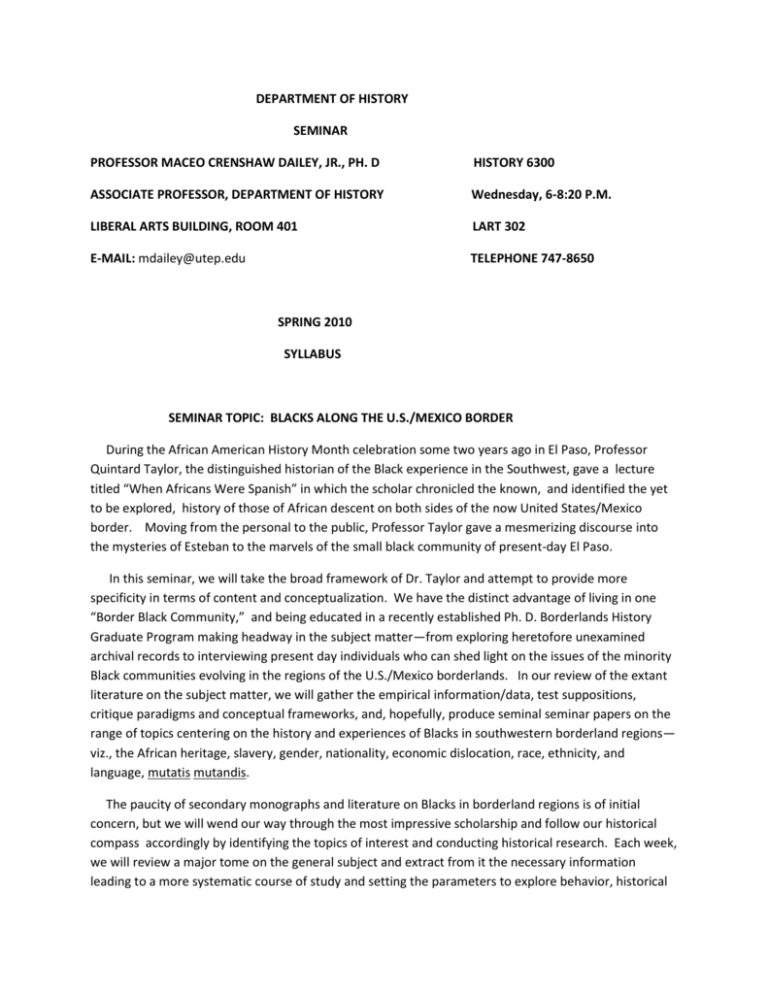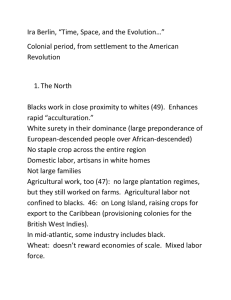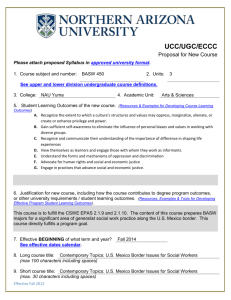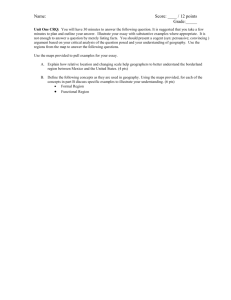Hist. 6300
advertisement

DEPARTMENT OF HISTORY SEMINAR PROFESSOR MACEO CRENSHAW DAILEY, JR., PH. D HISTORY 6300 ASSOCIATE PROFESSOR, DEPARTMENT OF HISTORY Wednesday, 6-8:20 P.M. LIBERAL ARTS BUILDING, ROOM 401 LART 302 E-MAIL: mdailey@utep.edu TELEPHONE 747-8650 SPRING 2010 SYLLABUS SEMINAR TOPIC: BLACKS ALONG THE U.S./MEXICO BORDER During the African American History Month celebration some two years ago in El Paso, Professor Quintard Taylor, the distinguished historian of the Black experience in the Southwest, gave a lecture titled “When Africans Were Spanish” in which the scholar chronicled the known, and identified the yet to be explored, history of those of African descent on both sides of the now United States/Mexico border. Moving from the personal to the public, Professor Taylor gave a mesmerizing discourse into the mysteries of Esteban to the marvels of the small black community of present-day El Paso. In this seminar, we will take the broad framework of Dr. Taylor and attempt to provide more specificity in terms of content and conceptualization. We have the distinct advantage of living in one “Border Black Community,” and being educated in a recently established Ph. D. Borderlands History Graduate Program making headway in the subject matter—from exploring heretofore unexamined archival records to interviewing present day individuals who can shed light on the issues of the minority Black communities evolving in the regions of the U.S./Mexico borderlands. In our review of the extant literature on the subject matter, we will gather the empirical information/data, test suppositions, critique paradigms and conceptual frameworks, and, hopefully, produce seminal seminar papers on the range of topics centering on the history and experiences of Blacks in southwestern borderland regions— viz., the African heritage, slavery, gender, nationality, economic dislocation, race, ethnicity, and language, mutatis mutandis. The paucity of secondary monographs and literature on Blacks in borderland regions is of initial concern, but we will wend our way through the most impressive scholarship and follow our historical compass accordingly by identifying the topics of interest and conducting historical research. Each week, we will review a major tome on the general subject and extract from it the necessary information leading to a more systematic course of study and setting the parameters to explore behavior, historical causality and phenomenology, and how we, as scholars, approach places where people have lived and continue to do so as time evolves and attitudes change. At the end of nine weeks, we should be poised to talk more comprehensively and, perhaps, cogently on the general issues pertaining to the history of Blacks along the U.S./Mexico border. The next five weeks will be set aside for individual research on a selected topic, completion of a seminar paper, and return to class for a detailed and vigorous review and critique of each student’s paper. The format for the general review of literature as well as the student’s paper is: A) B) C) D) E) F) G) H) Biographical overview of the scholar Why the scholar turned to the particular topic Assumptions of the scholar Thesis Evidence on which the thesis based Critical questions left unanswered by the scholar The scholar’s success as detective and interpreter of the subject matter A related historiography that we should know about to contextualize the scholar’s work At the graduate level, scholarly comportment is expected at all times, so one does not need to spellout the particulars. One word of caution, however, is vital pertaining to plagiarism. All submitted work should be in your language and reflect your synthesis. When drawing on language or thoughts of other scholars and individuals, be certain to give them credit in the acknowledgments or with the use of quotation marks. Grading will be based equally (50%-50%) on your classroom verbal participation/presentations and the seminar paper. Required books for the course: Gonzalo Aguirre Beltran, La Problacion Negra de Mexico Conrey Bryson, Dr. Lawrence A. Nixon and the White Primary Bruce A. Glasrud and James M. Smallwood, The African American Experience in Texas Gerald Horne, Black and Brown: African Americans and the Mexican Revolution, 1919-1920 James Leiker, Racial Borders: Black Soldiers Along The Rio Grande 21 January INTRODUCTION Discussion of assignments and requirements Ivan Karp et. al, Museums and Communities: The Politics of Public Culture, pp.506-92 Thomas C. Holt and Elsa Barkley Brown, Major Problems In African American History pp. 1-34 Ramon A. Gutierrez, “Borderlands,” Encyclopedia of American Cultural and Intellectual History, edited by Mary Cayton and Peter Williams, pp. 541-46 Beverly Daniel Tatum, “Talking About Race, Learning About Racism,” The Black Studies Reader, edited by Jacqueline Bobo et. al., pp. 389-413. 28 January The Distant Past Rayford Logan, “Estevanico: Negro Discoverer of the Southwest, A Critical Reexamination,” Phylon, Fourth Quarter, l940, Vol. I, No. 4 Ivan Van Sertima, They Came Before Columbus (All) Colin Palmer, Slaves of the White God (All) Benjamin Vincent, Blacks in His Majesty’s Army (All) Sagrario Cruz-Carretero, La presencia Africana en Mexico, pp. 14-60 Henry Flipper, “Early History of El Paso,”pp. 88-95 (handout) 4 February The Recent Past Barbara Krairthama, Blacks on the Border: African Americans’ Transition From Slavery To Freedom In Texas and Indian Territory, l8361907 Bruce A. Glasrud and James M. Smallwood, The African American Experience in Texas (All) Maceo Crenshaw Dailey, Jr., “Border Black: The El Paso Story,” Digame, edited by Christine Brenner et. al, pp. 307-25 Minority Rights Group, No Longer Invisible, pp. 163-81 11 February The In Between In Mexico The African Presence in Mexico: From Yanga To The Present (Mexican Fine Arts Center) Gonzalo Aguirre Beltran, La Problacion Negra de Mexico (All) 18 February The In Between In the United States Quintard Taylor, In Search of the Racial Frontier Harry Lawson, The History of African Americans in Tucson (All) Geta LeSeur, Not all Okies are White: The Lives of Black Cotton Pickers in Arizona (All) James Leiker, Racial Borders: Black Soldiers Along The Rio Grande (All) Gerald Horne, Black and Brown: African Americans and the Mexican Revolution (All) Arnoldo De Leon, Racial Frontiers: Africans, Chinese, and Mexicans in Western America, 1848-1890 (All) 25 February Border Realities and Race Maceo Crenshaw Dailey, I’m Building Me A Home (All) Conrey Bryson, Dr. L. A. Nixon and The White Primary (All) John Collyns Fullmore, “The Dragon: History of Douglass School,” (All) Jane Eppinga, Henry Ossian Flipper Charles M. Robinson, The Court Martial of Lt. Henry Flipper Valerie Abel-Coindoz, “Attitudes envers les Afro-americains a El Paso a travers Les editions du El Paso Times entre 1945 et 1978,” (handout) John David Marquez, “From Bebop to Hip Hop: A Comparative Analysis of Cultural Resistance in Mexican American and African American Communities, l940-l996,” M.A. Thesis, UTEP, l996 4 March Border Realities and Gender Maceo Crenshaw Dailey and Kristine Navarro, Wheresoever My People Chance To Dwell, (All) Bernice Love Wiggins, Tuneful Tales (edited by Maceo Dailey and Ruthe Winegarten) (All) Susan Pratt, We Are Here: Activism Among Black El Paso Women, l955-l965 M. A. Thesis 11 March Border Realities and Nationality George Reid Andrews, Afro-Latin America, l800-2000 (All) Kevin Mulroy, Freedom On The Border (All) Rosalie Schwartz, “Across The Rio To Freedom” (All) 25 March Intersections and Interactions With The “Other” Vijay Prashad, Everybody Was Kung Fu Fighting: Afro-Asian Connections And The Myth of Cultural Purity (All) Martha Menchaca, Recovering History, Constructing Race: The Indian, Black And White Roots of Mexican Americans. Benjamin Vincent, A Tuskegee Airman In Mexico Shelley Hatfield, Chasing Shadow Indians Along the U.S.-Mexico Border Ellwyn R. Stoddard, The U.S.-Mexico Borderland As a Multicultural Region








